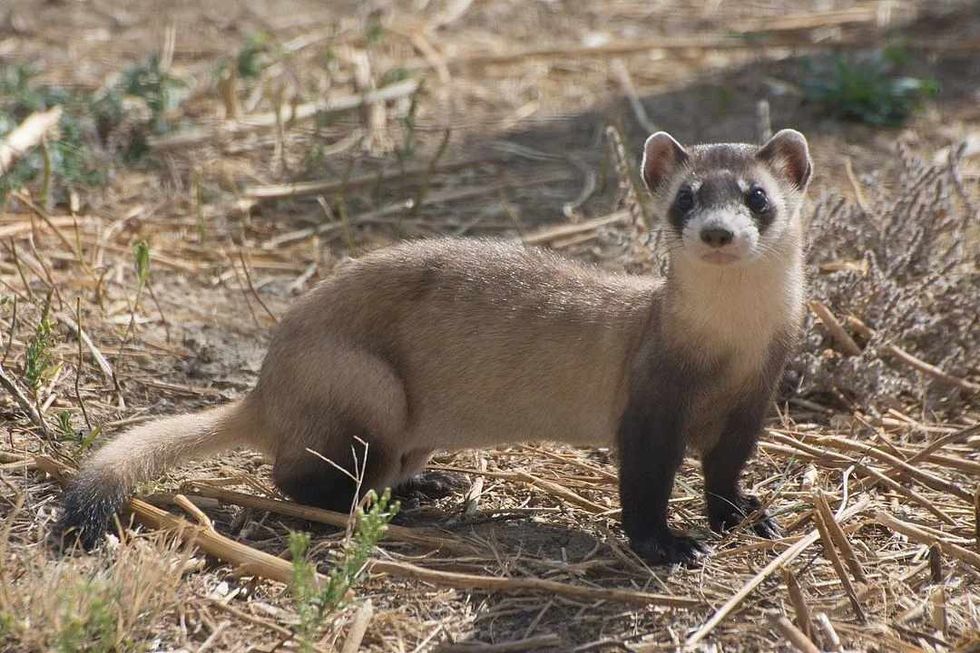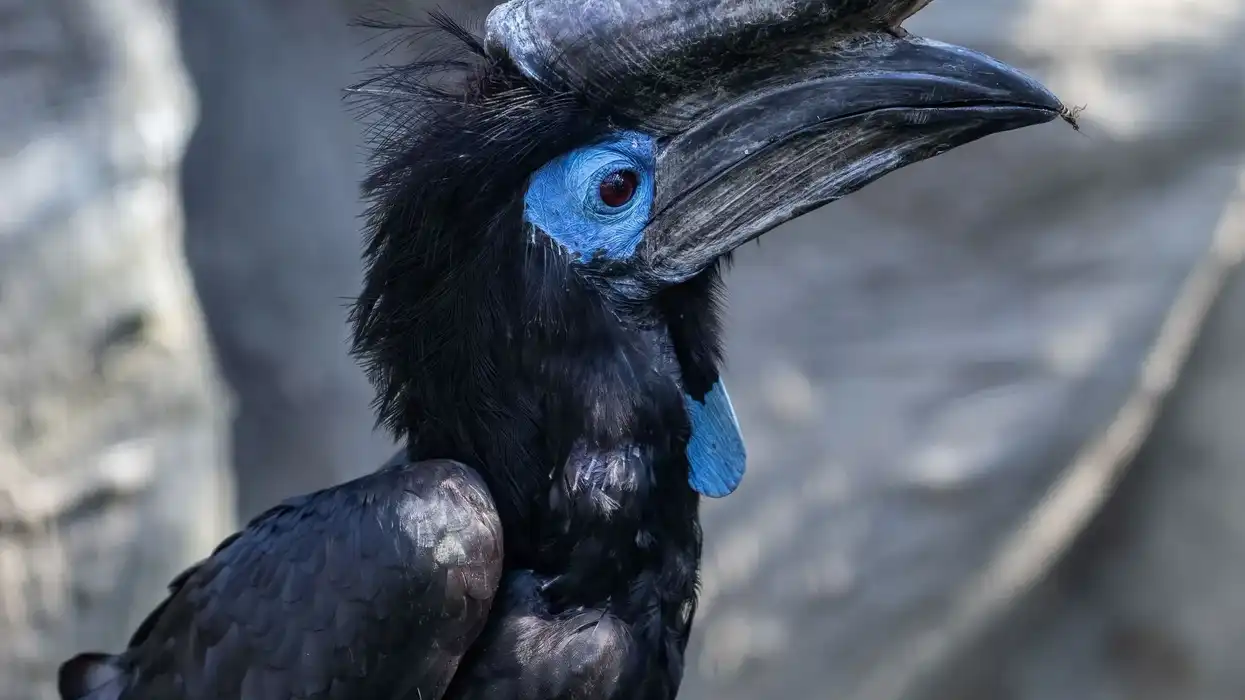The Black-Footed Ferrets (Mustela nigripes) are native to North America. These mammals are currently among the most endangered animals.
Once abundant across the western plains, they were thought to be extinct until 1981, when a small population of the ferret was rediscovered. Over the last 30 years, concerted efforts were made by many scientists, conservationists, federal agencies, animal rights organizations, zoos, Native American tribes, and private landowners to restore the population of these ferrets.
These recovery efforts bore fruit, and as of 2020, we have about 300 of these animals living across the regions of North America. The Smithsonian Conservation Biology Institute played a significant role in giving these animals a second chance at survival.
These animals are also commonly known as the prairie dog hunter or the American polecat. They can easily camouflage themselves with their prairie surroundings.
The mammals usually have a slender frame and are of short height. Their front paws and claws are large, allowing them to dig through their natural habitat. They have a strong sense of sight and hearing; however, the smell is their strongest sense which helps them hunt their prey in the dark.
Habitat loss is a major threat to these mammals. They have a lifespan of about three to four years in the wild.
Want to know more interesting facts about the Black-Footed Ferrets? Then continue reading. You may also like facts on leopard seal and fennec fox.
Black-Footed Ferret Interesting Facts
What type of animal is a Black-Footed Ferret?
The Black-Footed Ferret is a carnivorous mammal belonging to the family of Mustelids. They are the only species of ferrets that are native to grassland North America. The color of their body fur is usually yellow-buff, while their face, feet, and tail tip are black. They belong to the weasel family.
What class of animal does a Black-Footed Ferret belong to?
The Black-Footed Ferrets (Mustela nigripes) are mammals and predators of order Carnivora and belongs to the weasels family.
How many Black-Footed Ferrets are there in the world?
The Black-Footed Ferret is classified as an Endangered species and was, in fact, once thought to be extinct. Loss of prairie dog colonies, human intolerance, plague, and natural habitat loss are the main threats to these animals. However, reintroduction and captive breeding programs have led to the population of these animals increasing to about 300.
Where does a Black-Footed Ferret live?
Black-Footed Ferrets have the natural capacity to live in the temperate grasslands of the North American Great Plains. One major criterion for their habitat is that it should have prairie dog colonies around, as the main diet of these ferrets include them.
They are important for managing the prairie dogs population on the plains as well as providing food for their own predator populations.
These ferrets can live throughout southern Canada to northern Mexico. As a part of their reintroduction program, they have been reintroduced in parts of Arizona, Wyoming, Montana, and South Dakota.
What is a Black-Footed Ferret's habitat?
A Black-Footed Ferret habitat includes the temperate grasslands stretching across North American Great Plains where prairie dogs thrive. The ferrets prey on these dogs and use these prairie dog burrows as their own to raise their young ones. They were originally found across the United States, Mexico, and Canada.
Who do Black-Footed Ferrets live with?
Black-Footed Ferrets live on their own, only barring the breeding season when the male ferrets become territorial and mark and protect their territories from other males of the species. The breeding season usually starts from March-April and the gestation period is of 41-43 days, after which the kits are born.
The average litter comprises three to four kits; however, there have been instances when eight to nine kits have been born in a single birth.
How long does a Black-Footed Ferret live?
The average lifespan for the Black-Footed Ferrets from one to three years in the wild, while it can range from four to six years while they are held captive.
How do they reproduce?
The breeding season usually ranges from March to April, which is the only time the male and female ferrets are found together. Otherwise, they live solitarily.
The gestation period usually ranges from 41-43 days, after which the females give birth to a litter of kits. Their litters usually have three to four kits, though instances of single births have also been recorded. In some rare cases, a litter has also contained eight to nine kits.
The females are the only caregivers of the young ones. Prairie dog burrows are used to sleep and bring up the young ones.
What is their conservation status?
The Black-Footed Ferrets are an endangered species. Habitat loss, plague, non-native diseases are all threats to this species.
In addition to these factors, the sylvatic plague has been resulting in the loss of the prairie dog populations, which further leads to the threat of extinction since the Black-Footed Ferret's diet mainly (about 90%) consists of prairie dogs. The lives of these ferrets depend entirely on the prairie dog colonies.
This led to them almost going extinct in the wild.
Captive breeding programs and reintroduction by conservationists have resulted in the number of these ferrets slightly increase. There are currently about 300 of these Black Footed Ferrets.
Black-Footed Ferret Fun Facts
What do Black-Footed Ferrets look like?
These mammals have a small body frame and are roughly about the size of a mink. They have yellow-buff color fur covering most parts of their body, while their underbelly and the top of their head is almost white. As their name suggests, the fur on their feet is black.
How cute are they?
The Black-Footed Ferret, also known as the American polecat, is quite cute. The young kits are born blind and helpless and look extremely adorable. The adult ones also are quite pretty with their small body frame.
How do they communicate?
The Black-Footed Ferrets mostly chatter loudly whenever they have to sound an alarm. They hiss softly when they are scared or agitated. Female ferrets whimper to make their young ones follow.
How big is a Black-Footed Ferret?
The Black-Footed Ferret is about as tall as the average minks. They weigh around a kilogram and have a small, slender body frame.
How fast can a Black-Footed Ferret move?
It is not exactly known how fast can the Black-Footed Ferret move; however, some estimates can be made from the fact that they travel around 11 mi (18 km) in search of their prey.
How much does a Black-Footed Ferret weigh?
The Black-Footed Ferret weighs around 1.5-2.5 lb. They are small in size.
What are their male and female names of the species?
The female Black-Footed Ferrets are called jills while the males are called hobs.
What would you call a baby Black-Footed Ferret?
The Black Foot Ferret babies are called kits.
What do they eat?
About 90% of the Black-Footed Ferret's diet comprises prairie dogs. In addition to that, they also prey on mice, rats, ground squirrels, rabbits, birds, insects, and reptiles.
Are they dangerous?
No records have been found stating that the Black-Footed Ferrets are dangerous to humans.
Would they make a good pet?
They fall under the list of U.S. endangered species; hence, you are not allowed to keep these ferrets as pets.
Did you know...
Here are some fascinating facts about the Black-Footed Ferret. These animals have been cloned to protect them from going extinct in the wild. The first-ever clone of the Black-Footed Ferret was named Willa.
The ferrets themselves are susceptible to the sylvatic plague, which also infects prairie dogs; human influenza is various other diseases that threaten to cause their extinction. Primary mortality causes include loss of habitat and poisoning from eating infected prairie dogs.
These ferrets are preyed on by predators like owls in the wild, which increases the risk of their extinction in the wild. Coyotes are apex predators which also hunt these ferrets in the wild. In order to provide them protection, a breeding program has been launched.
They were once thought to have been extinct before being rediscovered again in 1981.
The underbelly of these ferrets is lighter in color, while the top of their heads is almost white. 90% of the diet of these mammals comprises prairie dogs. Their sense of smell is the most important factor which helps them hunt.
The females are usually the sole caregivers responsible for raising young ones.
Recently they are being trained in a conservation center in Colorado called National Black-Footed Ferret Conservation Center before being let out into the wild. Ferret reintroduction sites and programs have also been started.
Is the Black-Footed Ferret endangered?
Yes, the Black-Footed Ferret is endangered. Loss of natural habitat and the declining population of prairie dogs have threatened the existence of these ferrets.
Dwindling prairie dog populations, as well as natural plagues like the sylvatic plague, have adversely affected these ferrets. However, recent Black-Footed Ferret conservation efforts and breeding programs are undertaken by scientists and conservationists have shown results, and there has been some ferret recovery.
Various conservation center has come into existence which helps in the reproduction and care of the young ones.
Different types of Black-Footed Ferret
Black-Footed Ferrets belong to the species of ferrets that are found in North America. No particular sub-category is found under these mammals.
Here at Kidadl, we have carefully created lots of interesting family-friendly animal facts for everyone to discover! Learn more about some other mammals including prairie dogs, or plains zebra.
You can even occupy yourself at home by drawing one on our Black-Footed Ferret coloring pages.









